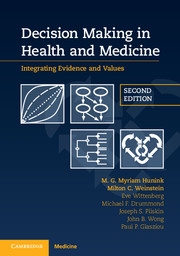Book contents
- Frontmatter
- Dedication
- Contents
- Foreword
- Foreword to the first edition (2001)
- Preface
- Acknowledgments
- list of Abbreviations
- About the authors
- 1 Elements of decision making in health care
- 2 Managing uncertainty
- 3 Choosing the best treatment
- 4 Valuing outcomes
- 5 Interpreting diagnostic information
- 6 Deciding when to test
- 7 Multiple test results
- 8 Finding and summarizing the evidence
- 9 Constrained resources
- 10 Recurring events
- 11 Estimation, calibration, and validation
- 12 Heterogeneity and uncertainty
- 13 Psychology of judgment and choice
- Index
- References
8 - Finding and summarizing the evidence
Published online by Cambridge University Press: 05 October 2014
- Frontmatter
- Dedication
- Contents
- Foreword
- Foreword to the first edition (2001)
- Preface
- Acknowledgments
- list of Abbreviations
- About the authors
- 1 Elements of decision making in health care
- 2 Managing uncertainty
- 3 Choosing the best treatment
- 4 Valuing outcomes
- 5 Interpreting diagnostic information
- 6 Deciding when to test
- 7 Multiple test results
- 8 Finding and summarizing the evidence
- 9 Constrained resources
- 10 Recurring events
- 11 Estimation, calibration, and validation
- 12 Heterogeneity and uncertainty
- 13 Psychology of judgment and choice
- Index
- References
Summary
It is surely a great criticism of our profession that we have not organized a critical summary, by specialty or subspecialty, adapted periodically, of all relevant randomized controlled trials.
Archie CochraneIntroduction
Good decision analyses depend on both the veracity of the decision model and on the validity of the individual data elements. These elements may include probabilities (such as the pre-test probabilities, the sensitivity and specificity of diagnostic tests, the probability of an adverse event, and so on), estimates of effectiveness of interventions (such as the relative risk reduction), and the valuation of outcomes (such as quality of life, utilities, and costs). Often we lack the information needed for a confident assessment of these elements. Decision analysis, by structuring a decision problem, makes these gaps in knowledge apparent. Sensitivity analysis on these ‘soft’ numbers will also give us insight into which of these knowledge gaps is most likely to affect our decisions. These same gaps exist in less systematic decision making as well, but there is no convenient way to determine how our decisions should be affected. In this chapter we shall cover the basic methods for finding the best estimate for each of the different elements that may be included in a formal decision analysis or in less systematic decision making.
Sometimes, but not as often as one would like, the estimates one is looking for can be inferred from a published study or from a series of cases that someone has reported in the literature or recorded in a data bank. This is generally considered the most satisfactory way of assessing a probability, because it involves the use of quantitative evidence. Often we will have a choice of data sources, so it is useful to have some ‘rules’ to guide the choice of possible estimates. One helpful concept is the ‘hierarchy of evidence’ (see www.cebm.net) which explicitly ranks the available evidence; ‘perfect’ data will rarely be available, but we need to know how to choose the best from the available imperfect data. This choice will also need to be tempered by the practicalities and purpose of each decision analysis: what is feasible will differ with a range from the urgent individual patient decision to a national policy decision to fund an expensive new procedure.
Information
- Type
- Chapter
- Information
- Decision Making in Health and MedicineIntegrating Evidence and Values, pp. 209 - 236Publisher: Cambridge University PressPrint publication year: 2014
